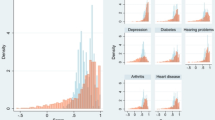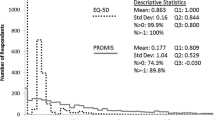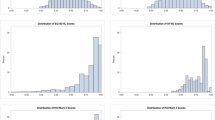Abstract
Background: For cost-utility analysis, analysts need a measure that summarizes health-status utilities in a single index of health-related quality of life (HR-QOL). It is common to find in clinical studies that only an HR-QOL profile measure such as the SF-36 is included, but not the summary HR-QOL index. Therefore, the economist’s usual practice is to reprocess the profile data into a single index format. Several ‘after-market’ tools are available to convert the SF-36 or SF-12 into a single form with or without utility-weighting metric property. However, there has been no consensus with regard to a regression method that should be recommended for such a mapping task.
Objective: To report on the performance of different regression methods that have previously been applied to the conversion of SF-12 data in the analysis of a single common dataset. The mapping between the SF-12 and EQ-5D is the focus.
Methods: The data were adopted from the Medical Expenditure Panel Survey 2003 where 19 678 adults completed both EQ-5D and SF-12 questionnaires. Four econometric techniques, namely ordinary least squares (OLS), censored least absolute deviation, multinomial logit model and two-part model regressions were investigated together with two main types of model specifications: item-based and summary score-based. The performance of each examined model was judged by various criteria, including its estimated mean, the size of mean absolute error and the number of errors.
Results: Among four compared econometric techniques, OLS regression was the most accurate model in estimating the group mean. Models with item-based model specification performed better than those with summary scorebased regardless of the chosen econometric technique. Nevertheless, the accuracy of OLS deteriorates in older and less healthy subgroups. The results also suggested that the two-part model, which addresses the heterogeneity issue, performs better in these vulnerable subgroups.
Conclusions: None of the mapping methods included in the current study are suitable for estimating at the individual level. The methodology exemplified here has wider applicability and might just as readily be applied to other members of the SF family or indeed to other profile measures of HR-QOL. However, it is recommended that a preference-based, single index measure of HR-QOL should be included in the clinical studies for the purpose of economic evaluation.







Similar content being viewed by others
Notes
To assist researchers wishing to undertake such a mapping task, all algorithms developed in the current study (in STATA format) are available online.[46]
References
Gold MR, Siegel JE, Russell LB, et al., editors. Cost-effectiveness in health and medicine. New York: Oxford University Press, 1996
Ware JE, Sonw KK, Kosinski M, et al. SF-36 health survey: manual and interpretation guide. Boston (MA): The Health Institute, New England Medical Center, 1993
Ware JE, Kosinski M, Keller SD. SF-36 physical and mental health summary scale: a user’s manual. Boston (MA): The Health Institute, New England Medical Center, 1994
Ware JE, Kosinski M, Turner-Bower D, et al. How to score version 2 of the SF-12 health survey. Lincoln (RI): QualityMetric, 2002
Mortimer D, Segal L. Comparing the incomparable? A systematic review of competing techniques for converting descriptive measures of health states into QALY-weights. Med Decis Making 2008; 28: 66–88
Bosch JR, Hunink MGM. The relationship between descriptive and valuation quality-of-life measures in patients with intermittent claudication. Med Decis Making 1996; 16: 217–25
Franks P, Lubetkin EI, Gold MR, et al. Mapping the SF-12 to preference-based instruments: convergent validity in a low-income, minority population. Med Care 2003; 41 (11): 1277–83
Franks P, Lubetkin EI, Gold MR, et al. Mapping the SF-12 to the EuroQol EQ-5D index in a national US sample. Med Decis Making 2004; 24 (3): 247–54
Fryback DG, Lawrence WF, Martin PA, et al. Predicting quality of well-being scores from the SF-36: results from the Beaver Dam Health Outcomes Study. Med Decis Making 1997; 17 (1): 1–9
Gray A, Rivero-Arias O, Clarke P. Estimating the association between SF-12 responses and EQ-5D utility values by response mapping. Med Decis Making 2006; 26: 18–29
Lawrence WF, Fleishman JA. Predicting EuroQoL EQ-5D preference scores from the SF-12 health survey in a nationally representative sample. Med Decis Making 2004; 24 (2): 160–9
Lundberg L, Johannesson M, Isacson DG, et al. The relationship between health-state utilities and the SF-12 in a general population. Med Decis Making 1999; 19 (2): 128–40
Nichol MB, Sengupta N, Globe DR. Evaluating quality-adjusted life years: estimation of the health utility index (HUI2) from the SF-36. Med Decis Making 2001; 21 (2): 105–12
Sengupta N, Nichol MB, Wu J, et al. Mapping the SF-12 to the HUI3 and VAS in a managed care population. Med Care 2004; 42 (9): 927–37
Shmueli A. The SF36 profile and health-related quality of life: an interpretive analysis. Qual Life Res 1998; 7: 187–95
Shmueli A. The relationship between the visual analogue scale and the SF-36 scales in the general population: an update. Med Decis Making 2004; 24 (1): 61–3
Shmueli A. Subjective health status and health values in the general population. Med Decis Making 1999; 19 (2): 122–7
Sullivan PW, Ghushchyan V. Mapping the EQ-5D index form the SF-12: US general population preferences in a nationally representative sample. Med Decis Making 2006; 26: 401–9
Tesvat J, Solzan JG, Kuntz KM, et al. Health values of patients infected with human immunodeficiency virus: relationship to mental health and physical function. Med Care 1996; 34: 44–57
Agency for Healthcare Research and Quality. Homepage [online]. Available from URL: http://www.ahrq.gov/ [Accessed 2006 Mar 23]
Agency for Healthcare Research and Quality (AHRQ). MEPS HC-079: 2003 full year consolidated data file [online]. Available from URL: http://www.meps.ahrq.gov/mepsweb/data_stats/download_data_files_detail.jsp?cboPufNumber=HC-079 [Accessed 2006 Mar 23]
Agency for Healthcare Research and Quality. Medical Expenditure Panel survey [online]. Available from URL: http://www.meps.ahrq.gov/mepsweb/ [Accessed 2006 Mar 23]
Ware JE, Kosinski M, Keller SD. How to score the SF-12 physical & mental health summary scales. 3rd ed. Lincoln (RI): QualityMetric, 1998
Brook R. EuroQol: the current state of play. Health Policy 1996; 37: 53–72
Rabin R, de Charro F. EQ-5D: a measure of health status from the EuroQol Group. Ann Med 2001; 33: 337–43
Szenda A, Oppe M, Devlin N, editors. EQ-5D value sets: inventory, comparative review and user guide. Dordrecht: Kluwer Academic Publishers, 2007
Kind K, Brooks R, Rabin R, editors. EQ-5D concepts and methods: a developmental history. Dordrecht: Kluwer Academic Publishers, 2005
Shaw JW, Johnson JA, Coons SJ. US valuation of the EQ-5D health states: development and testing of the D1 valuation model. Med Care 2005; 43 (3): 203–20
Powell J. Least absolute deviations estimation for the censored regression model. J Econometr 1984; 25: 303–25
Austin PC, Escobar M, Kopec JA. The use of the Tobit model for analyzing measures of health status. Qual Life Res 2000; 9: 901–10
Austin PC. Bayesian extension of the Tobit model for analyzing measures of health status. Med Decis Making 2002; 22: 152–62
Austin PC. A comparison of methods for analyzing health-related quality-of-life measures. Value Health 2002; 5 (4): 329–37
Cameron AC, Trivedi PK. Microeconometrics: methods and application. New York: Cambridge University Press, 2005
StataCorp. Stata statistical software: release 9.2. College Station (TX): Stata Corporation, 2007
Bult JR, Bosch JL, Hunink MG. Heterogeneity in the relationship between the standard-gamble utility measure and health-status dimensions. Med Decis Making 1996; 16: 226–33
Mortimer D, Segal L, Hawthorne G, et al. Item-based versus subscale-based mapping form the SF-36 to a preference-based quality of life measure. Value Health 2007; 10: 398–406
Hollingworth W, Deyo RA, Sullivan SD, et al. The practicality and validity of directly elicited and SF-36 derived health state preferences in patients with low back pain. Health Econ 2002; 11 (1): 71–85
Kaplan RM, Groessl EJ, Sengupta N, et al. Comparison of measured utility scores and imputed scores from the SF-36 in patients with rheumatoid arthritis. Med Care 2005; 43 (1): 79–87
Lee TA, Hollingworth W, Sullivan SD. Comparison of directly elicited preferences to preferences derived from the SF-36 in adults with asthma. Med Decis Making 2003; 23 (4): 323–34
McDonough CM, Grove MR, Tosteson TD, et al. Comparison of EQ-5D, HUI, and SF-36-derived social health state values among Spine Patient Outcome Research Trial (SPORT) participants. Qual Life Res 2005; 14: 1321–32
Lobo FS, Gross CR, Mattees BJ. Estimation and comparison of derived preference scores form the SF-36 in lung transplant patients. Qual Life Res 2004; 13: 377–88
Sherbourne CD, Unutzer J, Schoenbaum M, et al. Can utility-weighted HRQoL estimate capture health effect of quality improvement for depression? Med Care 2001; 39: 1246–59
Pickard AS, Wang Z, Walton SM, et al. Are decisions using cost-utility analyses robust to choice of SF-36/SF-12 preference-based algorithm? Health Qual Life Outcomes 2005; 3 (1): 1–11
Brazier JE, Roberts J. The estimation of a preference-based measure of health from the SF-12. Med Care 2004; 42 (9): 851–9
Kind P. York expert workshop in the social economic evaluation of medicines, model 3: quality of life. Dordrecht: Kluwer Academic Publishers, 2006
Chuang L-H. Homepage [online]. Available from URL: http://www.york.ac.uk/inst/che/staff/chuang.htm [Accessed 2009 Feb 4]
Sugar CA, Srurm R, Lee TT, et al. Empirically defined health states for depression form the SF-12. Health Serv Res 1998; 33 (4): 911–28
Lenert LA, Sherbourne CD, Sugar CA, et al. Estimation of utilities for the effects of depression from the SF-12. Med Care 2000; 38 (7): 763–70
Acknowledgements
Paul Kind is Principal Investigator for Quality Outcomes (QUO), which specializes in the use of outcome measures including EQ-5D. L-H Chuang has no conflicts of interest that are directly relevant to the content of this study.
No sources of funding were used to assist in the preparation of this study.
Author information
Authors and Affiliations
Corresponding author
Rights and permissions
About this article
Cite this article
Chuang, LH., Kind, P. Converting the SF-12 into the EQ-5D. Pharmacoeconomics 27, 491–505 (2009). https://doi.org/10.2165/00019053-200927060-00005
Published:
Issue Date:
DOI: https://doi.org/10.2165/00019053-200927060-00005




